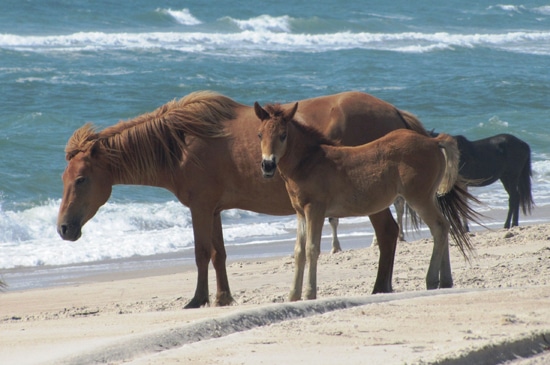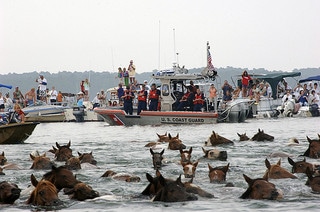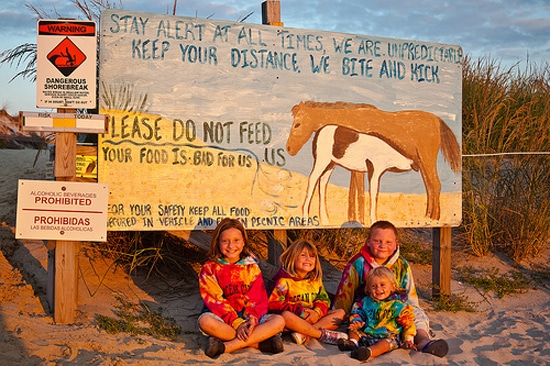
The latest addition to Assateague’s famed pony herd, N9BFQ-GL and his mom Harmony.
The latest addition to the Assateague pony herd was born sometime in mid-May. The sorrel foal was the first new edition to the wild pony herd in 2013. The National Park Service refers to him as, N9BFQ-GL.
Horse Talk: Sorrel – refers to a copper-red shade of chestnut with no black hairs and the same-color or lighter mane and tail.
The new foal was born to Harmony in a remote part of the island. Harmony also has an official number. Her number is N9BFQ-G.
The new foal’s current designation is taken from an alphanumeric system put in place by the National Park Service in the mid-1970s to track the lineage and ancestry of the wild horses and identify which sub-herd they belong to and the areas they frequent on the island.
Math Talk: Alphanumeric refers to a combined set of letters of the alphabet and the numbers 0 through 9.

Coast Guardsmen enforce a safety zone around the swimming wild horses at the 83rd Annual Pony Swim in Chincoteague, Va. Wednesday, July 30, 2008.
The alphanumeric system was developed by researcher Dr. Ronald Keiper. He began studying the Assateague horses in 1975 and developed a system that could identify, and trace the maternal ancestry of, each individual horse. (Maternal ancestry refers to the mother’s family line.) The system of alphanumeric identification numbers he came up with are now known as “Keiper numbers”.
At birth, each horse is assigned a Keiper number created by adding the letter for its birth year to its mother’s Keiper number. Birth years began in 1976 with A, B for foals born in 1977, C for 1978, up through Z in 2001. At that point the alphabet was started over with a dash in front of the letter, resulting in -A for foals born in 2002.
Below is a chart showing the letter designation for each year.
Using the chart above, let’s trace the new foal’s maternal ancestry.
1. Which letter in the new foal’s Keiper number, N9BFQ-GL, indicates the year she was born?
2. Harmony has the Keiper number N9BFQ-G. In what year was she born?
3. What is the Keiper number for Harmony’s mother?
4. In what year was Harmony’s mother born?

Camping on Assateague Island.
In 1975, when the system was first introduced there were only 44 horses in three harem bands living on the Maryland portion of Assateague Island.
Horse Talk: A harem band consists of a dominant stallion and his mares and immature offspring.
Each of these bands was designated by the letter M, N or T. The dominant stallion of each band was given the number 1, resulting in Keiper numbers M1, N1 and T1 for the stallions. The other horses in each band were numbered consecutively beginning with 2 (M2, M3, N2, N3, T2, etc.).
5. In the new foal’s maternal ancestry, what is the Keiper number for the first mare numbered back in 1975?
6. How many generations are indicated in the new foal’s Keiper number?
Assateague Welcomes New Foal Answers:
1. Which letter in the new foal’s Keiper number, N9BFQ-GL, indicates the year he was born?
Answer: L
2. Harmony has the Keiper number N9BFQ-G. In what year was she born?
Answer: 2008
3. What is the Keiper number for Harmony’s mother?
Answer: N9BFQ
4. In what year was Harmony’s mother born?
Answer: 1992
5. In the new foal’s maternal ancestry, what is the Keiper number for the first mare numbered back in 1975?
Answer: N9
6. How many generations are indicated in the new foal’s Keiper number?
Answer: 6 generations. (first generation: N9; 2nd generation: B; 3rd generation: F; 4th generation: Q; 5th generation: -G; 6th generation: -L)
Common Core:
5.OA.B Analyze patterns and relationships.
Photos:
Harmony and N9BFQ-GL courtesy of National Park Service
Annual Pony Swim by Coast Guard News; CC BY 2.0
Assateague Island by Jim Pennucci; CC BY 2.0







